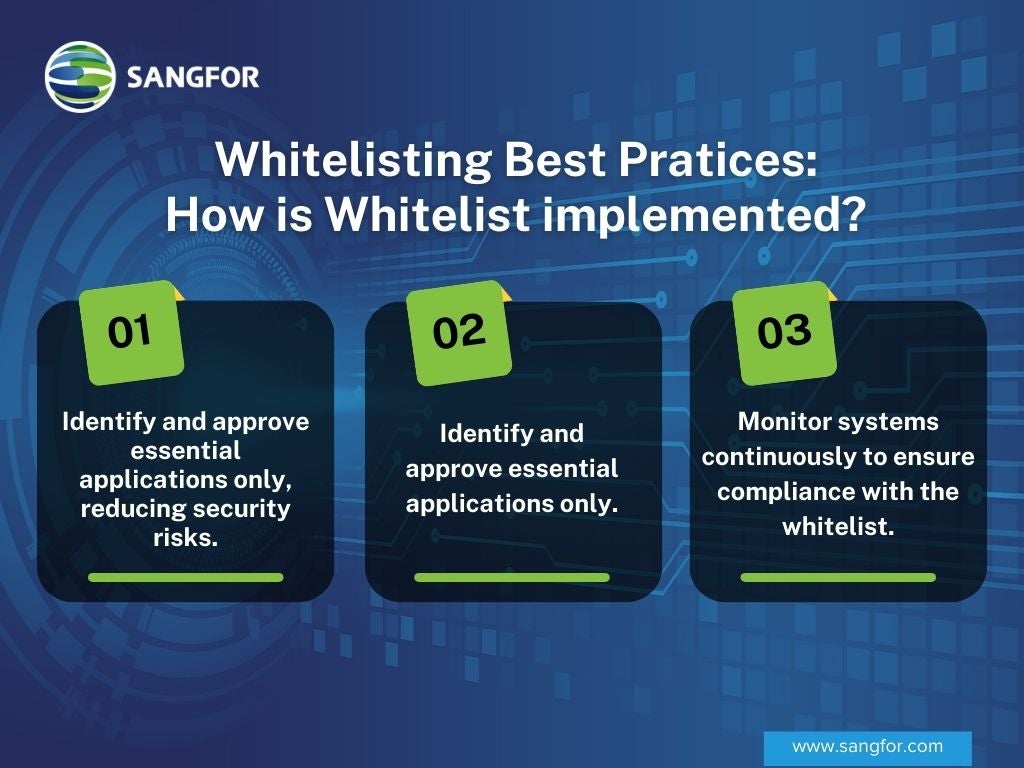What is a Whitelist?
To grasp the concept of a whitelist, envision attending an exclusive event. At the entrance, there's a doorman meticulously checking a list – a VIP guest list, if you will. If your name's on the list, you gain access; if not, you're denied entry. In the world of cybersecurity, a whitelist operates on a similar principle. But instead of names, you'll find IP addresses, email addresses, file paths, and software applications.Whitelisting is an approach where only pre-approved entities are allowed access to a specific service or environment, while all others are automatically denied by default. The roots of whitelisting can be traced back to early email servers where spam filters were used to combat spam, only allowing approved email addresses to send messages to users' inboxes, and blocking the rest from slipping into the junk folder.
What does Whitelist mean in cybersecurity?
In the vast landscape of cybersecurity, whitelisting serves as a crucial line of defense. A whitelist is a listthat comprises a range of items, such as approved IP addresses, recognized executable files, or even established digital signatures. This approved list aids the system administrator or IT administrator in granting access only to these approved entities, blocking any unknown or untrusted entities that might be potential cyber threats.
Whitelisting adds an extra layer of security to protect sensitive data and keep harmful files at bay. It ensures that only pre-approved programs can run on a protected computer, blocking the entry of unwanted software, and known malicious code. It serves as an effective cybersecurity strategy to prevent security breaches and safeguard enterprise-wide operations.

How does whitelisting work in cybersecurity?
It operates on an 'allow list' principle, only permitting interactions with approved entities. For instance, application whitelisting allows only specific applications to run on a system, blocking all others that aren't included in the list. But how is this process of approval established?Application whitelisting technologies use unique attributes to identify and whitelist applications. These attributes could include the file name, file size, or even a cryptographic hash that can identify the same files, even if they're located in different file paths. The list can be established and managed by the network administrator or IT administrator, allowing them to implement lists specific to their corporate network's needs. This approach provides a high degree of control, ensuring that only necessary and secure software is running within the network.
Whitelisting in Email Communications
Beyond cybersecurity, email whitelists play a significant role in ensuring the smooth delivery of email messages. For email marketers, getting their messages into the inboxes of recipients is crucial. By being added to a recipient's whitelist, often referred to as a list of safe senders, marketers can avoid spam filters and improve email deliverability. ISP whitelists are also used by Internet Service Providers to allow emails from trusted domains, ensuring that important communications aren't missed.
What are the benefits of whitelisting in cybersecurity?
Whitelisting solutions are rapidly becoming a cornerstone of robust cybersecurity defenses due to their numerous advantages. Unlike traditional antivirus software, which attempts to block malicious code after it's entered the system, whitelisting prevents the entry of harmful entities in the first place, reducing the chances of compromise. Application whitelisting, in particular, offers comprehensive protection. For instance, even if a new type of software enters the system and isn't immediately recognized as malware, if it's not on the application whitelist, it will still be blocked, thereby pre-empting potential damage.
In addition, whitelisting is highly effective in managing the challenge posed by zero-day attacks – threats exploiting previously unknown vulnerabilities. Since these attacks are not recognized by traditional anti-malware solutions, they often bypass defenses. However, with whitelisting, these unrecognized entities are automatically blocked, protecting the system against these unknown threats.
For email marketers, being on a recipient's email whitelist ensures that their email messages reach the intended audience, avoiding spam filters and improving engagement rates.
Whitelisting Best Pratices: How is Whitelist implemented?
Implementing a whitelist in a cybersecurity program might seem like a daunting task, but it doesn't have to be. A methodical, well-planned approach can effectively integrate application whitelisting into your security infrastructure. Let's understand the basic steps of this process:
- Establishing a baseline: Establishing a baseline of the software programs that are currently active on your corporate network is the first step. The executable files, libraries, configuration files, scripts, and other items associated with these apps should be identified, as well as their respective file locations and any file path associated with the said files.
- Creating the Whitelist: The next step is to create the lists. This step involves identifying and listing the applications that are approved for use within the network. Be meticulous with this step, only allowing applications that are necessary for your operations.
- Implementation and monitoring: Once it is created, it's time to implement it within your cybersecurity software. Following this, monitor the system diligently to ensure that only pre-approved programs are able to run. This will help in blocking unwanted software and prevent any potential security breaches.

The process of application whitelisting is facilitated by a variety of tools and technologies, each designed to address specific needs. Simplistic solutions can manage static IP whitelisting, making them quite straightforward to use. Conversely, for more complex requirements like handling dynamic IP addresses, there are intricate solutions that provide dynamic whitelisting capabilities. Each of these tools brings its own benefits to your cybersecurity strategy, making application whitelisting a flexible and adaptable approach to secure your systems.
What are the challenges in whitelisting?
While this solution can add a robust layer of protection to your network, the implementation comes with its fair share of challenges. The most common one is managing the approval process, especially in large-scale environments with a variety of software applications in use. The maintenance can be time-consuming. Constantly changing file paths, the advent of new software, and updates to existing programs all require diligent attention and timely updates to the list. Not doing so can lead to disruptions in service or, worse, potential security vulnerabilities.
However, these challenges can be mitigated by following a well-structured cybersecurity plan and implementing whitelists properly. Regular audits, the use of automated tools for maintaining and updating the lists, and providing end-users with adequate training can help in overcoming these hurdles.
How does whitelisting compare to blacklisting?
Whitelisting and blacklisting are two sides of the same cybersecurity coin. Where whitelisting operates by allowing access only to approved entities, blacklisting works by denying access to known malicious entities. While blacklisting, typically done by traditional antivirus software, is useful in blocking known malicious code and applications, it's often ineffective against new and emerging threats. This is where the proactive nature of whitelisting shines. By default, everything not included on the whitelist is treated as a potential threat and is denied access.
However, both techniques have their own strengths, and best practices suggest using them in combination for a comprehensive cybersecurity strategy. Whitelisting can be effectively used for corporate networks where the software requirements are well-defined, while blacklisting can be used to block known attack sites and malware on the broader internet.
Final thoughts
From controlling access to sensitive data to keeping harmful files at bay, whitelisting serves as an effective strategy for preventing security breaches and safeguarding operations. With Sangfor's Network Secureor Internet Access Gateway (IAG), this is all possible and done with ease. Using IP Whitelists serves as a robust control mechanism for managing access to your systems. This applies whether you are a network administrator, an IT professional, or simply an individual striving to enhance your digital security.
Watch this video to learn more about how Sangfor’s IAG Data Loss Prevention Solution can help secure your business environment:
Partnering with Sangfor brings this knowledge directly to your fingertips. As experts in cybersecurity, Sangfor can help you anticipate, understand, and counter potential attacks, and ensure you’re ahead of the curve.
Contact Us for Business Inquiry
Frequently Asked Questions
A whitelist in cybersecurity is a list of pre-approved entities like IP addresses, email addresses, applications, or software that are granted access to a system or network. All other entities are denied by default.
Email marketers can improve email deliverability by being added to a recipient's email whitelist or list of safe senders. This ensures their email messages bypass spam filters and reach the inbox.
Whitelisting best practices include identifying and approving only essential applications, regularly updating the whitelist, and continuous monitoring to ensure compliance.
Whitelisting allows only approved entities access, blocking all others, while blacklisting blocks known malicious entities but allows all others. Whitelisting is proactive, whereas blacklisting is reactive.
Yes, combining whitelisting with other security measures like blacklisting and traditional antivirus software provides a more comprehensive cybersecurity strategy.





